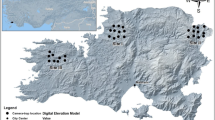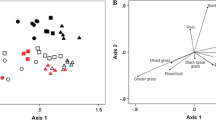Abstract
Several species of marsupials in Eucalyptus forests in Australia feed predominantly on the sporocarps of hypogeous fungi. This feeding is apparently beneficial to the fungi as it results in dispersal of spores. As these fungi are in almost all cases ectomycorrhiza-forming species, mycophagy by mammals may play an important role in the maintenance of mycorrhizal symbiosis in Eucalyptus forests. Fire is frequent and a dominant ecological factor in these forests, and this study tested the hypothesis that fire triggers both increased sporocarp production by some hypogeous ectomycorrhizal fungi associated with eucalypts, and increased mycophagy by mammals. Three experimental burns were set in E. tenuiramus forest in southeastern Tasmania. Digging activity (which reflects feeding on hypogeous fungi) by a mycophagous marsupial, the Tasmanian bettong Bettongia gaimardi, increased up to ten-fold after fire, with a peak about 1 month post-fire. This was associated with a similar pattern of increase in sporocarp production, which was due to species in the family Mesophelliaceae (especially Castoreum tasmanicum and Mesophellia spp.). This family appears to have radiated in association with eucalypts and has an exclusively Australasian distribution, unlike many of the other ectomycorrhizal fungi collected in this study which are cosmopolitan and have broad host ranges. No B. gaimardi were killed by fire, and there was no increase in mortality following fire. Population density increased after fire as a result of immigration of adult males. However, body condition and fecundity of individual B. gaimardi were maintained at pre-fire levels. This suggests that the availability of energy to B. gaimardi increased as a result of fire, and the fact that the contribution of fungus to the diet of B. gaimardi was high on burnt relative to control sites suggests further that this increase in energy availability was provided by hypogeous fungi. Effects of fire on hypogeous fungi and B. gaimardi were short-lived; all measured variables returned to control values about 4 months after fire. The capacity of B. gaimardi to survive fire and to harvest the increased sporocarp production triggered by fire provides a mechanism for the rapid dispersal of spores after fire. This should result in the establishment of ectomycorrhizae very early in post-fire succession. Because only some species of ectomycorrhizal fungi fruited in response to burning, fire probably has a strong influence on community structure among ectomycorrhizal fungi.
Similar content being viewed by others
References
Attiwill PM, Leeper GW (1987) Forest soils and nutrient cycles. Melbourne University Press, Melbourne
Bennett AF, Baxter BG (1989) Diet of the long-nosed potoroo Potorous tridactylus (Marsupialia: Potoroidae), in southwestern Victoria. Aust Wildl Res 16:263–271
Boerner REJ (1982) Fire and nutrient cycling in temperate ecosystems. BioScience 32:187–192
Bougher NL, Grove TS, Malajczuk N (1990) Growth and phosphorus acquisition of karri (Eucalyptus diversicolor F. Muell.) seedlings inoculated with ectomycorrhizal fungi in relation to phosphorus supply. New Phytol 114:77–85
Christensen P (1980) The biology of Bettongia penicillata (Gray, 1837) and Macropus eugenii (Desmarest 1917) in relation to fire. (Bulletin no. 91) Forests Department of Western Australia, Perth
Christensen P, Maisey K (1987) The use of fire as a management tool in fauna conservation reserves. In: Saunders DA, Arnold GW, Burbidge AA, Hopkins AJ (eds) Nature conservation: the role of remnants of native vegetation. Surrey Beatty, Sydney, pp 323–329
Christensen P, Recher H, Hoare J (1981) Responses of open forest to fire regimes. In: Gill AM, Groves RH, Noble IR (eds) Fire and the Australian biota. Australian Academy of Science, Canberra, pp 367–394
Claridge AW, Tanton MT, Seebeck JH, Cork SJ, Cunningham RB (1992) Establishment of ectomycorrhizae on the roots of two species of Eucalyptus from fungal spores contained in the faeces of the long-nosed potoroo (Potorous tridactylus). Aust J Zool 17:207–219
Donaldson R, Stoddart M (1994) Detection of hypogeous fungi by the Tasmanian bettong (Bettongia gaimardi: Marsupialia: Macropodidae). J Chem Ecol 20:1200–1204
Dunlop CR, Webb LJ (1991) Flora and vegetation. In Haynes CM, Ridpath MG, Williams MAJ (eds) Monsoonal Australia: landscape, ecology and man in the Northern Lowlands. Balkema, Rotterdam, pp 41–61
Gill AM (1981) Adaptive responses of Australian vascular plant species to fires. In: Gill AM, Groves RH, Noble IR (eds) Fire and the Australian biota. Australian Academy of Science, Canberra, pp 243–272
Gill AM, Groves RH, Noble IR (eds) (1981) Fire and the Australian biota. Australian Academy of Science, Canberra
Hobbs RJ, Atkins L (1988) Spatial variability of experimental fires in south-west Western Australia. Aust J Ecol 13:295–299
Humphreys FR, Craig FG (1981) Effects of fire on soil chemical, structural and hydrological properties. In: Gill AM, Groves RH, Noble IR (eds) Fire and the Australian biota. Australian Academy of Science, Canberra, pp 177–202
Johnson CN (1994a) Fruiting of hypogeous fungi in dry sclerophyll forest in Tasmania, Australia: seasonal variation and annual production. Mycol Res 98:1173–1182
Johnson CN (1994b) Distribution of feeding activity of the Tasmanian bettong (Bettongia gaimardi) in relation to vegetation patterns. Wildl Res 21:249–255
Johnson CN (1994c) Nutritional ecology of a mycophagous marsupial in relation to production of hypogeous fungi. Ecology 75:2015–2021
Johnson CN (1994d) Mycophagy and spore dispersal by a rat-kangaroo: consumption of ectomycorrhizal taxa in relation to their abundance. Funct Ecol 8:464–468
Lamont BB, Ralph CS, Christensen PE (1985) Mycophagous marsupials as dispersal agents for ectomycorrhizal fungi on Eucalyptus calophylla and Gastrolobium bilobum. New Phytol 101: 651–656
Malajczuk N, Trappe JM, Molina R (1987) Interrelationships among some ectomycorrhizal trees, hypogeous fungi and small mammals: Western Australian and north-western American parallels. Aust J Ecol 12:53–55
Mooney NJ, Johnson KA (1979) Methods for the census of wallaby and possum in Tasmania (Internal report). Tasmanian National Parks and Wildlife Service, Hobart
Taylor RJ (1991) Plants, fungi and bettongs: a fire-dependent coevolutionary relationship. Aust J Ecol 16:409–411
Taylor RJ (1993a) Habitat requirements of the Tasmanian bettong (Bettongia gaimardi), a mycophagous marsupial. Wildl Res 20:699–710
Taylor RJ (1993b) Home range, nest use and activity of the Tasmanian bettong Bettongia gaimardi. Wildl Res 20:87–95
Author information
Authors and Affiliations
Rights and permissions
About this article
Cite this article
Johnson, C.N. Interactions between fire, mycophagous mammals, and dispersal of ectromycorrhizal fungi in Eucalyptus forests. Oecologia 104, 467–475 (1995). https://doi.org/10.1007/BF00341344
Received:
Accepted:
Issue Date:
DOI: https://doi.org/10.1007/BF00341344




